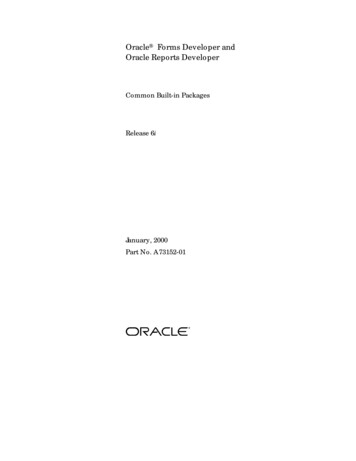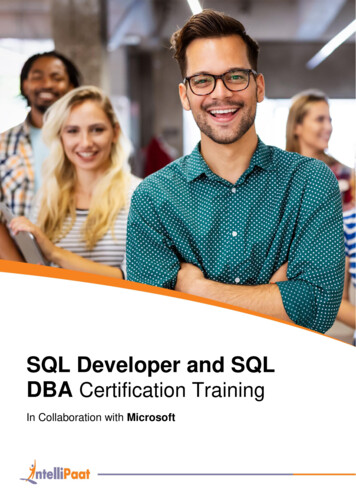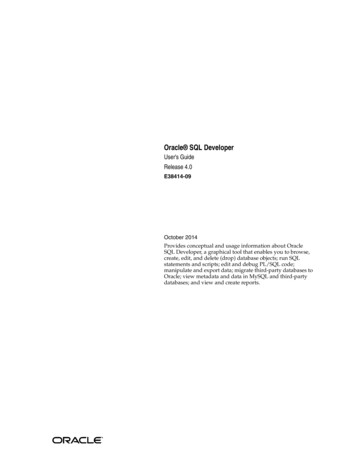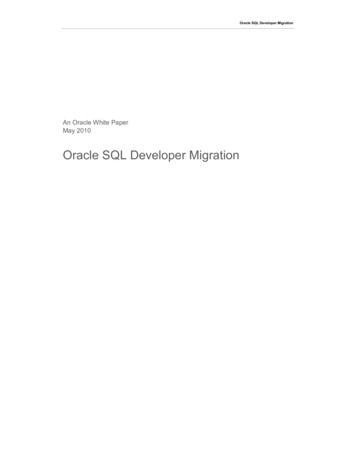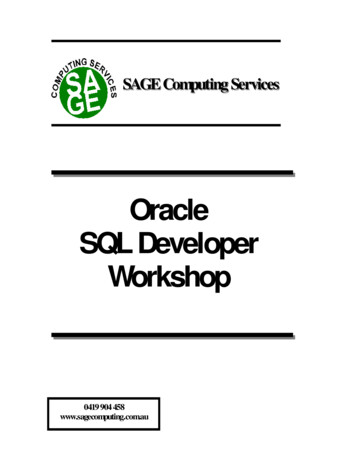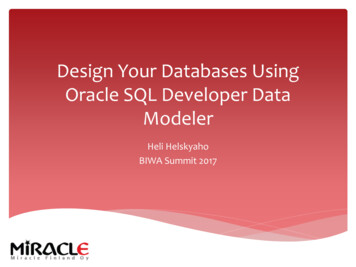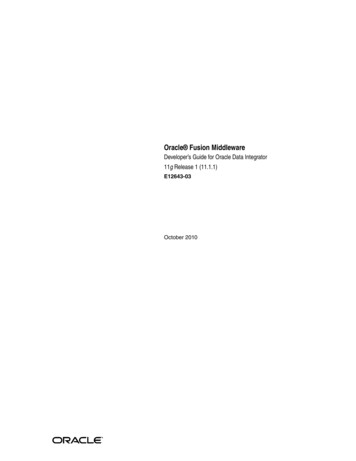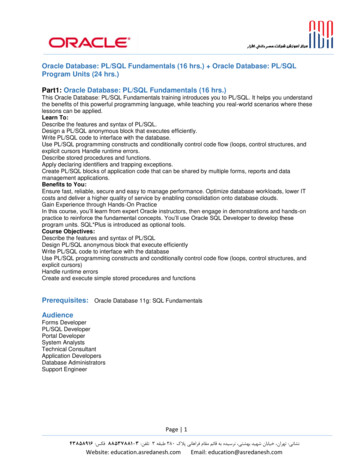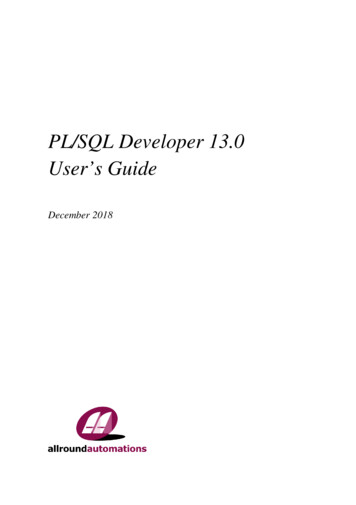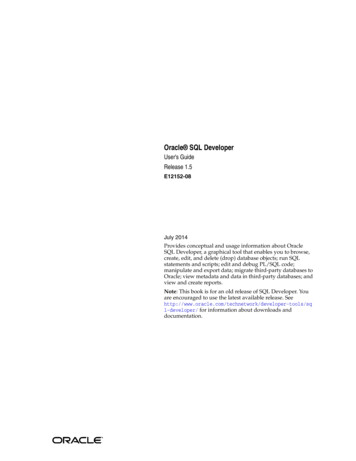
Transcription
Oracle SQL DeveloperUser's GuideRelease 1.5E12152-08July 2014Provides conceptual and usage information about OracleSQL Developer, a graphical tool that enables you to browse,create, edit, and delete (drop) database objects; run SQLstatements and scripts; edit and debug PL/SQL code;manipulate and export data; migrate third-party databases toOracle; view metadata and data in third-party databases; andview and create reports.Note: This book is for an old release of SQL Developer. Youare encouraged to use the latest available release. ls/sql-developer/ for information about downloads anddocumentation.
Oracle SQL Developer User's Guide, Release 1.5E12152-08Copyright 2006, 2014, Oracle and/or its affiliates. All rights reserved.Primary Author:Chuck MurrayThis software and related documentation are provided under a license agreement containing restrictions onuse and disclosure and are protected by intellectual property laws. Except as expressly permitted in yourlicense agreement or allowed by law, you may not use, copy, reproduce, translate, broadcast, modify, license,transmit, distribute, exhibit, perform, publish, or display any part, in any form, or by any means. Reverseengineering, disassembly, or decompilation of this software, unless required by law for interoperability, isprohibited.The information contained herein is subject to change without notice and is not warranted to be error-free. Ifyou find any errors, please report them to us in writing.If this is software or related documentation that is delivered to the U.S. Government or anyone licensing iton behalf of the U.S. Government, the following notice is applicable:U.S. GOVERNMENT END USERS: Oracle programs, including any operating system, integrated software,any programs installed on the hardware, and/or documentation, delivered to U.S. Government end usersare "commercial computer software" pursuant to the applicable Federal Acquisition Regulation andagency-specific supplemental regulations. As such, use, duplication, disclosure, modification, andadaptation of the programs, including any operating system, integrated software, any programs installed onthe hardware, and/or documentation, shall be subject to license terms and license restrictions applicable tothe programs. No other rights are granted to the U.S. Government.This software or hardware is developed for general use in a variety of information managementapplications. It is not developed or intended for use in any inherently dangerous applications, includingapplications that may create a risk of personal injury. If you use this software or hardware in dangerousapplications, then you shall be responsible to take all appropriate fail-safe, backup, redundancy, and othermeasures to ensure its safe use. Oracle Corporation and its affiliates disclaim any liability for any damagescaused by use of this software or hardware in dangerous applications.Oracle and Java are registered trademarks of Oracle and/or its affiliates. Other names may be trademarks oftheir respective owners.Intel and Intel Xeon are trademarks or registered trademarks of Intel Corporation. All SPARC trademarksare used under license and are trademarks or registered trademarks of SPARC International, Inc. AMD,Opteron, the AMD logo, and the AMD Opteron logo are trademarks or registered trademarks of AdvancedMicro Devices. UNIX is a registered trademark of The Open Group.This software or hardware and documentation may provide access to or information on content, products,and services from third parties. Oracle Corporation and its affiliates are not responsible for and expresslydisclaim all warranties of any kind with respect to third-party content, products, and services. OracleCorporation and its affiliates will not be responsible for any loss, costs, or damages incurred due to youraccess to or use of third-party content, products, or services.
ContentsPreface . xiiiAudience.Documentation Accessibility .Related Documents .Conventions .Third-Party License Information.1xiiixiiixiiixiiixivSQL Developer Concepts and Usage1.1Installing and Getting Started with SQL Developer. 1-21.2SQL Developer User Interface. 1-21.2.1Menus for SQL Developer. 1-61.2.2Restoring the Original "Look and Feel". 1-91.3Database Objects . 1-91.3.1Applications (Application Express 3.0.1 and Later) . 1-101.3.2Cache Groups (Oracle TimesTen In-Memory Database) . 1-101.3.3Database Links (Public and Private) . 1-111.3.4Directories . 1-111.3.5Functions. 1-111.3.6Indexes. 1-121.3.7Java Sources . 1-121.3.8Materialized Views. 1-121.3.9Materialized View Logs . 1-121.3.10Packages . 1-131.3.11Procedures . 1-131.3.12Queues. 1-141.3.13Queue Tables . 1-141.3.14Recycle Bin. 1-141.3.15Replication Schemes (Oracle TimesTen In-Memory Database). 1-141.3.16Sequences . 1-151.3.17Synonyms (Public and Private) . 1-151.3.18Tables. 1-151.3.18.1Flashback Table Support . 1-161.3.19Triggers . 1-171.3.20Types. 1-171.3.21Users (Other Users) . 1-17iii
1.3.22Views .1.3.23XML Schemas .1.3.24Captured and Converted Database Objects (for Migration) .1.4Database Connections .1.4.1Using Folders to Group Connections .1.4.2Sharing of Connections .1.4.3Advanced Security for JDBC Connection to the Database .1.4.4Connections with Operating System (OS) Authentication.1.4.5Connections with Proxy Authentication .1.5Entering and Modifying Data .1.6Running and Debugging Functions and Procedures .1.6.1Using Bookmarks When Editing Functions and Procedures .1.6.2Remote Debugging .1.6.3Displaying SQL Trace (.trc) Files .1.6.4Using the PL/SQL Hierarchical Profiler .1.6.5Setting Expression Watches .1.7Using the SQL Worksheet.1.7.1SQL*Plus Statements Supported and Not Supported in SQL Worksheet.1.7.2Script Runner.1.7.3Execution Plan.1.7.4Autotrace Pane .1.7.5DBMS Output Pane .1.7.6OWA Output Pane .1.7.7SQL History .1.7.8Gauges: In the SQL Worksheet and User-Defined Reports.1.8Using Snippets to Insert Code Fragments.1.8.1User-Defined Snippets .1.9Using Find DB Object to Find Database Objects .1.10Using Extended Search .1.11Using Versioning .1.11.1About CVS and SQL Developer .1.11.1.1Pending Changes (CVS) .1.11.2About Subversion and SQL Developer .1.12SQL Developer Reports.1.12.1About Your Database reports .1.12.2All Objects reports .1.12.3Application Express reports.1.12.4ASH and AWR reports.1.12.5Charts reports.1.12.6Database Administration reports .1.12.7Data Dictionary reports .1.12.8Jobs reports .1.12.9PL/SQL reports.1.12.10Security reports .1.12.11Streams reports .1.12.12Table reports.1.12.13XML 1-391-401-401-401-401-411-411-411-411-421-421-44
1.12.14Migration reports.1.12.15User Defined reports .1.12.15.1User-Defined Report Example: Chart.1.12.15.2User-Defined Report Example: Dynamic HTML.1.13SQL Developer Preferences .1.13.1Environment .1.13.2Accelerators (Keyboard Shortcuts) .1.13.3Code Editor.1.13.4Compare and Merge.1.13.5Database .1.13.6Debugger.1.13.7Extensions .1.13.8File Types .1.13.9Global Ignore List .1.13.10Migration.1.13.11Versioning.1.13.12Web Browser and Proxy .1.14Location of User-Related Information .1.15Oracle TimesTen In-Memory Database Support.1.16Using the Help.1.17For More rating Third-Party 32.62.6.12.6.22.7Migration Quick Start. 2-2Standard Migration . 2-2Quick Migration. 2-3Overview of Migration. 2-5How Migration Works . 2-5Migration Implemented as SQL Developer Extensions. 2-6Preparing a Migration Plan . 2-6Task 1: Determining the Requirements of the Migration Project . 2-6Task 2: Estimating Workload . 2-8Task 3: Analyzing Operational Requirements . 2-9Task 4: Analyzing the Application. 2-9Task 5: Planning the Migration Project. 2-10Before You Start Migrating: General Information. 2-10Creating a Database User for the Migration Repository. 2-11Requirements for Creating the Destination Oracle Objects. 2-11Before You Start Migrating: Source-Specific Information. 2-12Before Migrating From Microsoft SQL Server or Sybase Adaptive Server. 2-12Before Migrating From Microsoft Access. 2-13Creating Microsoft Access XML Files. 2-15Before Migrating From MySQL. 2-15Capturing the Source Database . 2-15O
Oracle SQL Developer User's Guide Release 1.5 E12152-08 July 2014 Provides conceptual and usage information about Oracle SQL Developer, a graphical tool that enables you to browse, create, edit, and delete (drop) database objects; ru
